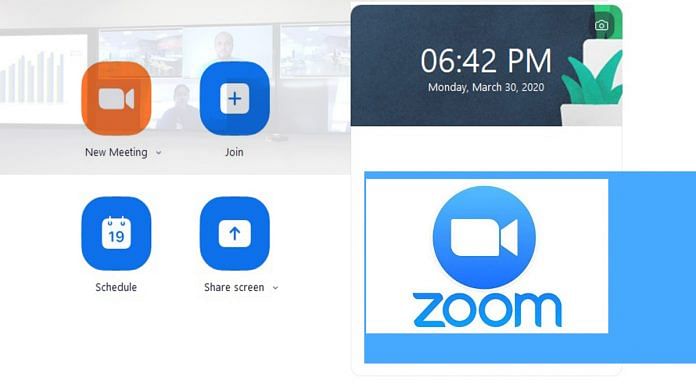New Delhi: Before the coronavirus pandemic hit the world, chances are you hadn’t heard of the Zoom app. But after the virus forced people into quarantine, it has almost become the default app for video-conferencing, conducting online classes, and even meeting friends for virtual hangouts.
Zoom describes itself as a video communications service for enterprises, but it has gone beyond that description. A few days ago, on 28 March, India’s oldest political party, the Congress, conducted a video conference and its first online press conference on Zoom.
विपत्ति कि इस घड़ी में भी राष्ट्रहित के काम नहीं रुकने चाहिए। @INCIndia पार्टी के कार्यकर्ताओं को अपने दायित्वों का बोध है। इसलिए, एक सकारात्मक विपक्ष की भूमिका निभाते हुए, आज वीडियो कांफ्रेंसिंग के जरिए बैठक और प्रेस ब्रीफिंग की गई।#IndiaFightsCorona pic.twitter.com/8P489ZXdXu
— Abhishek Singhvi (@DrAMSinghvi) March 29, 2020
People are now arranging exercise and fitness routines on Zoom, and hosting motivational meetings to “Fight Corona When Everyone is Home!!!!”

Also read: Missing your friends? Here’s the app that can help you during lockdown
The immigrant who became ‘No.1 top CEO’
Zoom Video Communications was founded back in 2011 by Chinese immigrant Eric S. Yuan. It is headquartered in California.
Yuan, a billionaire since April 2019 when the company stock went public, is originally from China’s Shandong province, and studied at the Shandong University of Science and Technology. He even had a start-up in Beijing before moving to the US.
Yuan landed in Silicon Valley in 1997, at the age of 27, after having his visa application rejected eight times. At the time, he could barely speak English, CNBC has reported.
He picked up the language from his teammates as he worked his first job in Silicon Valley — writing code for WebEx, an online video conference system, that is the largest in the market, according to Bloomberg. Yuan’s company now competes with WebEx.
Networking hardware giant Cisco acquired WebEx in 2007 for $3.2 billion; at the time, Yuan was its head of engineering.
He left the company four years later, and took his passion and expertise (Yuan owns multiple patents related to real-time collaboration) in video communication and collaboration software to build Zoom.
Yuan felt the new age of smartphones and mobile devices could be better used for an array of collaborative video communications that other competing software did not provide.
According to CNBC, Yuan noted that “the problem with those products is that nobody enjoys using them”, adding that the “buggy code” he wrote for WebEx two decades ago is still running today.
Most of Yuan’s initial investors and Zoom employees were those who had worked with him at Cisco and WebEx. According to this CNBC report, they joined Yuan and Zoom because they believed in his capability, and the team he had put together.
To this day, Yuan carries a reputation for being a good boss at Zoom, which now has over 2,500 employees. In 2018, job and employer review site Glassdoor named Yuan the ‘number one top CEO’, while in 2019, Zoom was ranked No.2 on Glassdoor’s ‘best places to work’ list.
Also read: More than Netflix it’s Instagram, TikTok and Snapchat that are uniting a quarantined world
Zoom’s success in the time of coronavirus
Zoom’s free-to-use, reliable service has made it the go-to app for people looking for video-conferencing services.
According to stock market insight provider Nasdaq.com, first-time installations of Zoom’s mobile app increased 213 per cent in the week of 16-22 March compared to the week before (9-15 March), and 728 per cent compared to the week before that. Nasdaq was citing data from app download monitoring firm Sensor Tower.
“Zoom’s mobile app was installed about 3.7 times more than Skype’s, and 8.6 times more than Google Hangouts,” said Randy Nelson from Sensor Tower.
Even before the novel coronavirus became a worldwide crisis, a February 2020 CNBC report, cited research analysts as saying that Zoom gained 2.22 million monthly active users in just the first 50-odd days of 2020, compared to 1.99 million users in the whole of 2019.
Soaring usage has made Zoom’s stock one of the few to beat the coronavirus blues affecting other big companies. In March, Zoom’s market cap temporarily even surpassed cab aggregator Uber’s.
Also read: Animal crossing is Nintendo’s gift to a corona-weary world
What makes Zoom a success
A reason for wide adoption could be that Zoom offers a mix of free and paid services. But so does WebEx, whose free meeting video service can be used for any time period, unlike Zoom’s, which is capped at 40 minutes per session.
However, Zoom’s most premium offering for large enterprises is cheaper at $19.99 per month per host, while WebEx’s enterprise plan is reportedly more expensive at $26.95 per month per host. WebEx doesn’t publish pricing on its site.
According to users’ reactions on software review site TrustRadius, it’s not that competitors’ products are bad, but that Zoom is just easier to use and reliable.
“There have been less than a handful of outages during our two years with Zoom,” says Stefan Scherbik, a tech professional at a healthcare facility.
IT network engineer Diana Anderson says: “It just works. Biggest complaint with our previous solution is that it took 10 minutes to connect to a meeting. Now, our users connect instantaneously.”
Add to that features like Zoom’s beauty filter to make yourself look better on-camera during video meetings, or a fun Snapchat filter to add angel wings and a halo to yourself during meetings, and Zoom is probably here to stay even after the coronavirus pandemic goes away.
Also read: Mumbai start-up builds AI-based X-ray technology to help detect Covid-19



